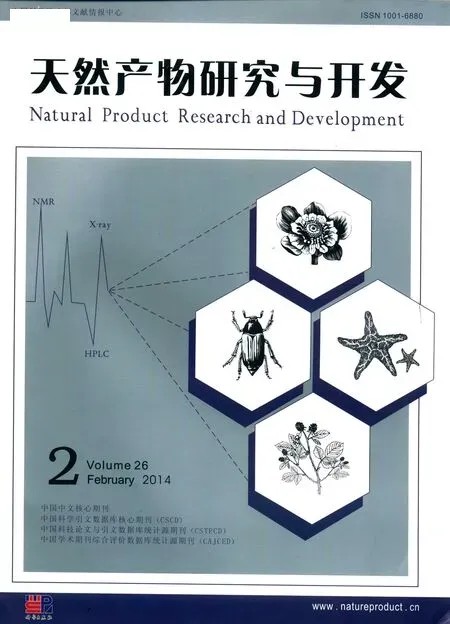生氰糖苷類物質的結構和代謝途徑研究進展
柳春梅,呂鶴書
北京農學院 農業部都市農業(北方)重點實驗室,北京 102206
生氰糖苷(Cyanogentic glycosides)亦稱氰苷,作為具有防御功能的次生代謝產物已在包括蕨類,裸子植物和被子植物在內的2500 多種植物中被發現,它們儲存于液泡中,當植物組織遭到破壞,如食草動物侵襲或病原體入侵,生氰糖苷與降解酶相接觸,釋放有毒物質HCN 和酮(或醛)類物質,提供植物一個立即的防御對抗。在對橡膠產膠量的研究中,發現植物中的生氰糖苷還具有轉運、存儲氮元素的作用。在4 億多年植物和動物共同進化的過程中,動物可以從外界獲取或是自身合成該類化合物為己所用[1],因此在動物界,主要在一些節肢動物和昆蟲中存在生氰糖苷,這類物質既可作為化學防御物質,也可作為性信息素,在擇偶和交配期起到重要作用[2-4]。本文對該類物質的結構類型、合成和降解途徑等方面進行綜述,為深入研究該類化合物在植物和動物中的作用提供資料。
1 生氰糖苷的結構
生氰糖苷是氰醇衍生物的羥基和D-葡萄糖縮合形成的糖苷(圖1),根據取代基不同主要分為脂肪族生氰苷和芳香族生氰苷。該類化合物主要由三種脂肪族蛋白質氨基酸(L-valine,L-isoleucine,Lleucine),兩種芳香族氨基酸(L-phenylalanine,Ltyrosine)以及一種脂肪族非蛋白質氨基酸(2-(2'-Cyclopentenyl)-glycine)衍生而來[5],結構綜述如下(圖2,3)

圖1 生氰糖苷的基本結構式Fig.1 Basic chemical structure of cyanogentic glycosides
2 生氰糖苷的生物合成

圖2 芳香族生氰糖苷的結構式Fig.2 Chemical structures of aromatic cyanogenic glycoside

圖3 脂肪族生氰糖苷的結構式Fig.3 Chemical structures of aliphatic cyanogenic glycoside
生氰糖苷生物合成過程中涉及3 大類酶,分別屬于CYP79、CYP71 家族的兩種細胞色素CYP450(也稱P450)及葡萄糖轉移酶UGT8581。CYP450 是一類以還原態與CO 結合后在波長450 nm 處有吸收峰的含血紅素的單鏈蛋白質[43](圖4)。不同植物中合成生氰糖苷的部位有所差異,例如高粱CYP79A1 主要表達于幼苗;日本百脈根CYP79D3主要表達在葉子,而CYP79D4 在根組織上表達相對低,表明生氰糖苷的積累發生在頂端組織;在木薯中,生氰糖苷先在地上部分合成,隨后運送到根部貯存,第一片展開的葉子和葉柄具有最高的生氰苷生物合成活性。高粱、利馬豆、葡萄、苦杏仁、亞麻籽中的生氰苷類物質研究較多。在生氰苷中作用的第一個酶是細胞色素P450,其生物合成途徑是α-氨基酸羥基化形成N-羥基氨基酸,然后形成醛肟,進一步形成腈。生氰糖苷生物合成的最后一步是由糖基轉移酶催化的半氰醇的糖基化反應。

圖4 生氰糖苷生物合成途徑Fig.4 Biosynthetic pathway of cyanogenic glycoside
3 生氰糖苷的降解
生氰糖苷本身不呈現毒性,在正常植物體內生氰糖苷和(-葡萄糖苷酶并不會相遇,當草食動物或病原體損傷生氰植物組織時,組織內的β-葡萄糖苷酶(β-Glucosidase)與生氰糖苷相遇,對其進行降解,隨后α-羥腈酶(α-Hydroxynitrile lyase)降解細胞內的生氰類化合物,生成并釋放出有毒的氰化氫以及葡萄糖和醛或酮,即產生化學防御反應(圖5)。正常情況下,植物體內產生的極少量HCN 可通過體內不同的途徑進行脫毒反應,轉化為無毒化合物(圖6)。

圖5 生氰苷降解途徑Fig.5 degradation pathway of cyanogenic glycoside

圖6 HCN 在體內不同的脫毒反應途徑Fig.6 Detoxification pathway of HCN in vivo
4 結語
目前已發現2000 多種植物,多種細菌、真菌以及鱗翅目昆蟲體內含有生氰糖苷類物質,這類物質的結構類型變化較少,主要是脂肪族、芳香族取代的單糖或二糖類的生氰糖苷。迄今為止,國內外對生氰糖苷類物質的研究,多限于該類物質的分離和鑒定方面,對生氰糖苷的代謝途徑的研究僅限于木薯、高粱、百脈根等少數植物。因此,對含氰植物體內生氰糖苷的生物合成途徑以及抗蟲抗病機理的深入研究,將為其作為基因資源增強農作物抗病蟲害能力具有重要意義,同時有助于人為地調控生成途徑中的基因,從而干擾其毒性物質的產生,對提高含氰植物的食用安全性,同樣具有重要意義。
1 Mika Z,et al.Cyanogenic glucosides in the biological warfare between plants and insects:The Burnet moth-Birdsfoot trefoil model system.Phytochemistry,2011,72:1585-1592.
2 Bak S,et al.Cyanogenic glycosides;a case study for evolution and application of cytochromes P450.Phytochem Rev,2006,5:309-329.
3 Mφller BL,et al.Biosynthesis of cyanogenic glucosides,cyanolipids and related compounds.In:Singh,B.K.(Ed.),Plant Amino Acids.M.Dekker,New York,1999.563-609.
4 Zagrobelny M,et al.Cyanogenic glucosides and plant-insect interactions.Phytochemistry,2004,65:293-306.
5 Zhang Y(張巖),et al.Research progress of cyanogentic glycosides in plant.Biotechnology Bulletin(生物技術通報),2009,4:12-15.
6 Yang CJ,et al.Two new cyanogenic glucosides from the leaves of Hydrangea macrophylla.Molecules,2012,17:5396-5403.
7 Jin QH,et al.Chemical constituents from the fruits of Prunus mume.Nat Prod Sci.2012,18:200-203.
8 Miller RE,et al.Reports on the distribution of aromatic cyanogenic glycosides in Australian tropical rainforest tree species of the Lauraceae and Sapindaceae.Phytochemistry,2013,92:146-152.
9 Tan HP,et al.Characterisation of galloylated cyanogenic glucosides and hydrolysable tannins from leaves of phyllagathis rotundifolia by LC-ESI-MS/MS.Phytochemical Analysis,2011,22:516-525.
10 Swenson WK,et al.Cyanogenesis in the Proteaceae.Phytochemistry,1989,28:821-823.
11 Schwarzmaier U,et al.The cyanogenesis of Bambusa vulgaris and B.guadua.Chemische Berichte,1976,109:379-389.
12 Otsuka H,et al.Glochidiolide,isoglochidiolide,acuminaminoside,and glochidacuminosides A-D from the leaves of Glochidion acuminatum Muell.Chemical & Pharmaceutical Bulletin,2004,52:591-596.
13 Fu P,et al.New flavonoid glycosides and cyanogenic glycosides from Dracocephalum peregrinum.Chemical & Pharmaceutical Bulletin,2009,57:207-210.
14 Miller R,et al.The rare cyanogen proteacin,and dhurrin,from foliage of Polyscias australiana,a tropical Araliaceae.Phytochemistry,2013,93:210-215.
15 Franks TK,et al.Cyanogenic glucosides in grapevine:polymorphism,identification and developmental patterns.Phytochemistry,2005,66:165-173.
16 Zhou WJ,et al.Chemical comparison of two dosage forms of hemp seed pills by UHPLC-Q-ToF-MS/MS and multivariate statistical techniques.J Pharm Biomed Anal,2013,84:59-68.
17 Lee JY,et al.Quantification of amygdalin in nonbitter,semibitter,and bitter almonds(Prunus dulcis)by UHPLC-(ESI)QqQ MS/MS.J Agric Food Chem,2013,61:7754-7759.
18 Turczan JW,et al.Cyanogenetic glycosides.The 220 MHz nuclear magnetic resonance studies of amygdalin and some related compounds.J-Association of Official Analytical Chemists,1978,61:192-207.
19 Miller RE,et al.A galloylated cyanogenic glycoside from the Australian endemic rainforest tree Elaeocarpus sericopetalus(Elaeocarpaceae).Phytochemistry,2006,67:1365-1371.
20 Chassagne D,et al.A cyanogenic glycoside from Passiflora edulis fruits.Phytochemistry,1998,49:757-759.
21 Nagumo S,et al.Cyanogenic glycosides and 4-hydroxycoumarin glycosides from Gerbera jamesonii hybrid.Chemical &Pharmaceutical Bulletin,1985,33:4803-4806.
22 Derbre S,et al.Automating a 96-well microtiter plate assay for identification of AGEs inhibitors or inducers:application to the screening of a small natural compounds library.Analytical and Bioanalytical Chemistry,2010,398:1747-1758.
23 Aritomi M,et al.Chemical studies on the constituents of edible plants.Part 4.Cyanogenic glycosides in leaves of Perilla frutescens var.acuta.Phytochemistry,1985,24:2438-2439.
24 Miller RE,et al.Cyanogenic glycosides from the rare Australian endemic rainforest tree Clerodendrum grayi(xLamiaceae).Phytochemistry,2006,67:43-51.
25 Selmar D,et al.Dhurrin-6'-glucoside,a cyanogenic diglucoside from Sorghum bicolor.Phytochemistry,1996,43:569-572.
26 Wang GC,et al.Five new phenolic glycosides from Hedyotis scandens.Bioorgan & Med Chem Lett,2013,23:1379-1382.
27 Webber BL,et al.Constitutive polymorphic cyanogenesis in the Australian rainforest tree,Ryparosa kurrangii(Achariaceae).Phytochemistry,2007,68:2068-2074.
28 Jaroszewski JW,et al.Cyanohydrin glycosides of Passiflora:distribution pattern,a saturated cyclopentane derivative from P.guatemalensis,and formation of pseudocyanogenic αhydroxyamides as isolation.Phytochemistry,2002,59:501-512.
29 Olafsdottir ES,et al.Structure determination of natural epoxycyclopentanes by x-ray crystallography and NMR spectroscopy.J Org Chemistry,1991,56:2650-2655.
30 Jensen SR,et al.Gynocardin in Ceratiosicyos laevis(achariaceae).Phytochemistry,1986,25:2349-2350.
31 Bayoumi SAL,et al.Constituents and secondary metabolite natural products in fresh and deteriorated cassava roots.Phytochemistry,2010,71:598-604.
32 Webber BL,et al.Constitutive polymorphic cyanogenesis in the Australian rainforest tree,Ryparosa kurrangii(Achariaceae).Phytochemistry,2007,68:2068-2074.
33 Alberte RS,et al.Anti-inflammatory and anti-allergy extracts from nettle.Dan.US 20100009927 A1 20100114,2010.
34 Seigler DS,et al.New cyanogenic glycoside from Cardiospermum hirsutum.Phytochemistry,1974,13:2330-2332.
35 Maslin BR,et al.Cyanogenesis in Australian species of Acacia.Phytochemistry,1988,27:421-428.
36 Bjarnholt N,et al.Diversification of an ancient theme:Hydroxynitrile glucosides.Phytochemistry,2008,69:1507-1516.
37 Cai WH,et al.Supinaionosides A and B:megastigmane glucosides and supinanitrilosides A-F:hydroxynitrile glucosides from the whole plants of Euphorbia supina RAFINESQUE.Chemical & Pharmaceutical Bulletin,2009,57:840-845.
38 Kim DK,et al.A new cyanogenic glycoside from Sorbaria sorbifolia var.stellipila.Chem Pharm Bull,2000,48:1766-1767.
39 Nakamura S,et al.Bioactive constituents from Chinese natural medicines.XXVI.Chemical structures and hepatoprotective effects of constituents from roots of Rhodiola sachalinensis.Chem Pharm Bull,2007,55:1505-1511.
40 Nahrstedt A,et al.Characterization of cyanogenic glucoside and b-glucosidases in Triglochin maritima seedlings.Phytochemistry,1979,18:1137-1141.
41 Sharples D,et al.Major cyanogenic glycoside in Thalictrum aquilegifolium.Phytochemistry,1972,11:3069-3071.
42 Jaroszewski JW,et al.Biosynthesis of cyanohydrin glucosides from unnatural nitriles in intact tissue of Passiflora morifolia and Turnera tifolia.Phytochemistry,1996,42:649-654.
43 Mika Z,et al.Cyanogenesis in plants and arthropods.Phyto-chemistry,2008,69:1457-1468.

